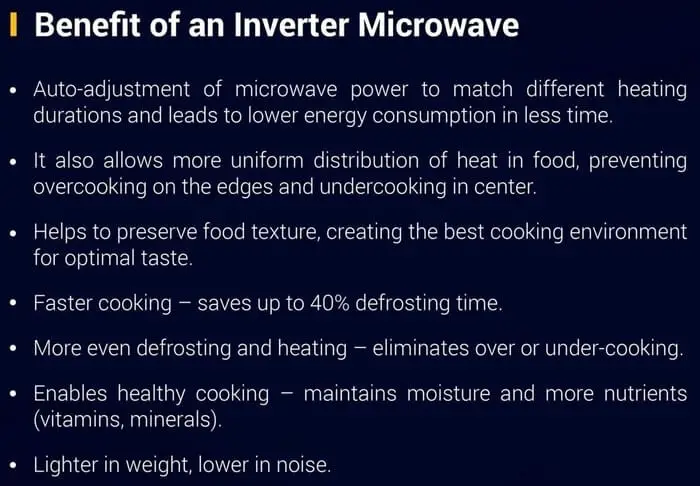If looking for an energy-efficient microwave oven, you will most likely love an inverter microwave. This microwave uses a power supply with an inverter instead of a transformer to help you cook food evenly.
The microwave uses an inversion circuit to deliver a constant stream of power, which leads to more evenly cooked food and faster cooking times.
Inverter technology lets the microwave control the energy supplied to the magnetron. It makes it easy for you to control the output level you want from the magnetron.
And unlike in non-inverter microwaves, where you have to switch the magnetron on and off to facilitate cooking at a certain energy level, here, the required energy level is easy to select.
Well, we just got started; pitch your tent here to learn the benefits of an inverter microwave.
But before that…
How Does an Inverter Microwave Work?
Inverter microwaves work by defrosting, heating, or reheating foods at a constant stream of power during the entire cooking process.
It cooks food just like any other regular microwave, but due to the consistent supply of microwaves by the inverter circuit, food gets cooked more evenly and consistently.
How Does an Inverter Microwave Differ from a Regular Microwave?
The main difference between an inverter and a regular microwave is how power is supplied. In a regular microwave, energy is supplied via a transformer which turns the power on and off and gives your food the chance to distribute heat.
This means that if you set a regular microwave to work at 50% power, the magnetron will work at full power(deliver 100% power) followed by a period of zero power to achieve the 50%.
This isn’t the case with inverter microwave ovens.
An inverter microwave supplies a steady and constant stream of power for the entire cooking time without cutting in and out.
This means that if you set the microwave to cook at 50% power, it’ll cook at the exact power throughout.
Benefits of an Inverter Microwave

When cooking, heat can be your friend or turn out to be your biggest enemy. Striking the perfect temperature balance gives you a well-done meal, while high temperatures will burn your food.
An inverter microwave offers you the following advantages:
1. More Evenly Cooked Food
Inverter microwaves cook food more evenly, unlike regular microwave ovens. With inverter models, the maximum temperature is easy to cap depending on the type of food to prevent the leaching of nutrients.
Inverter microwaves cook food better than non-inverter units do, and you’re less likely to end up with raw or partly cooked food.
2. Faster Cooking Times
Because you won’t have to cycle between full power and reduced power level with inverter microwaves, you’ll be able to cook faster.
3. More Energy-Efficient
Now that inverter microwaves cook faster, it also means that they are more energy-efficient. You can never compare these microwaves with regular ones that use a lot of power when cycling between full power and zero cooking power.
The consistent stream of power leads to a faster cooking time and less use of power.
4. Even Defrosting of Food
Do you know that a regular microwave will still have to cycle the power to defrost food? Quite an inconvenience, right? It can lead to under defrosted centers and dry outer edges, especially if defrosting thick foods.
The constant delivery of power in inverter microwaves makes defrosting of food more efficient. Your food will be thawed consistently and faster than when using a regular microwave.
5. Steady Power Supply
As aforementioned, inverter microwaves get a steady and consistent power supply that leads to evenly cooked food. With one, you are sure that your food will always cook at the intended/selected temperature, unlike with a conventional microwave oven.
6. Improved Temperature Control
Alternating between temperatures to get a medium temperature value can be pretty cumbersome. It actually gets worse when you need power at moderately low and moderately high levels.
With an inverter microwave, you don’t have to worry about getting the correct cooking temperature. The control is more streamlined, and you can simply choose the energy you want your food to cook in, and the inverter will supply the exact power to the magnetron.
7. Lightweight
Since inverter microwaves don’t come with a magnetron, they are much lighter. They actually tend to be 3kg lighter than a conventional microwave of the same size.
They are thus easier to move from one corner of your kitchen to the other.
Frequently Asked Questions
Q. Does an inverter microwave use less power?
Inverter microwaves use less power and cook food much better.
Q. Is an inverter microwave better than a regular microwave?
Yes, an inverter microwave is much better than a regular microwave. It cooks food faster, cooks at a consistent temperature during the whole cooking process, cooks food evenly, and thaws food more evenly than a regular microwave.
Q. Is an inverter microwave oven the same as a convection microwave?
The two are completely different and this is evidenced by how power is supplied.
In an inverter, microwave power is supplied through an inverter circuit, while in a convection microwave, it’s supplied via a transformer.
Q. What is the main advantage of an inverter microwave?
The main advantage of an inverter microwave is that it supplies a steady and consistent stream of power during the entire cooking time. This leads to more evenly cooked food.
Conclusion
When it comes to microwave ovens, simple changes and improvements in technology can make a big difference. These improvements dictate whether the model can cook faster or make evenly cooked meals.
Inverter technology is one of these improvements, and it enhances better temperature control that reduces the risk of undercooking or overcooking meals.
These microwaves are user-friendly, reliable and make cooking much easier hence a worthy investment.
